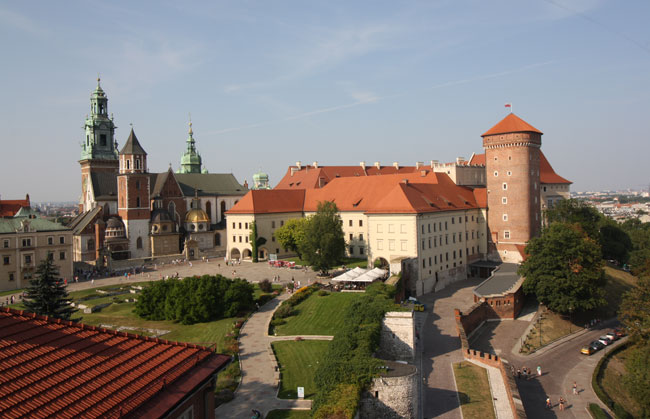

Climbing to the Tower
Old wooden floorboards creak with every step as I ascend the narrow stairwells, dodging and ducking under a crisscross of support beams. It’s only a 70-step climb up Krakow Cathedral’s Sigismund Tower.
At the top hangs an enormous bell – a celebrated national symbol – and the views stretch into the heart of the medieval Old Town spared from major damage during World War II.
Named after a Polish king, the 11-ton Sigismund Bell has tolled for such momentous and even horrific events in country’s turbulent history as the 1939 German invasion, and Pope John Paul II’s first visit as pontiff to his homeland when still under Communist rule.
Exciting View from the Window
But seeing where the eight-foot-wide bell first clanged in 1521 becomes even more exciting with a look out the window.
“We see the roofs of many churches because at the time when Krakow was the political capital of Poland, it was also the center of religious life,” city tour guide Marta Weigel explains as we look out at a skyline of red-roofed facades capped with Renaissance and Baroque steeples.
From up here, I can also see where medieval city walls once ringed the Old Town – the walls long gone, replaced with a leafy greenbelt and statue-studded park called the Planty.
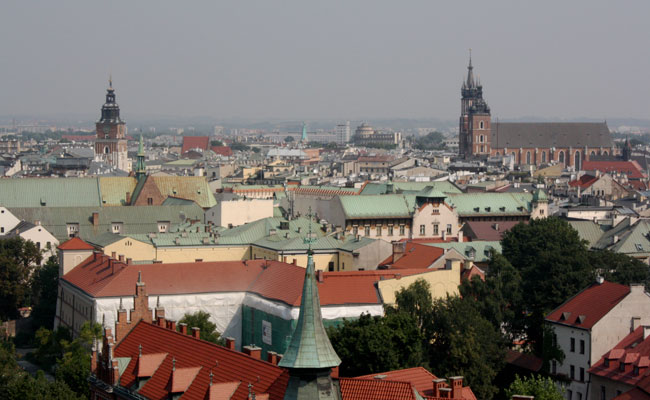
The Bell Tower
The bell tower is just one vantage point to see Krakow from above, giving the visitor – who’s up to the challenge of huffing and puffing up twisting narrow steps – a new perspective on exploring this Polish city.
Others include the medieval twin spires of St. Mary’s Church and the stand-alone Town Hall Tower, both looking down upon the pedestrian bustle of Market Square, one of Europe’s largest.
Krakow Cathedral, where Karol Wojtyla served as Archbishop before becoming pope, sits atop Wawel Hill within a walled fortress described by some as “Poland’s Acropolis” or Kremlin.
Climbing the 137 steps up Sandomierz, one of Wawel’s three redbrick watchtowers, offers an impressive aerial view of the Royal Palace with its ornate tapestry rooms and courtyard, and a broadside look at the Cathedral’s signature domed chapels housing the tombs of kings.
They include Sigismund Chapel, its gilded dome glimmering in the midday sun, and the adjacent Vasa Chapel with a Baroque, cherub-decorated interior.
The Amazing View
In Market Square, I twist and squirm while climbing Town Hall Tower, many of its 130 stone steps staggered and uneven.
The view, however, is worth every grunt when looking down upon pedestrians dodging fluttering pigeons near the elongated Cloth Hall market.
Diners huddle under umbrellas at outdoor cafés, and crowds cluster around accordion-squeezing and guitar-plucking street musicians hustling a few zloty coins.
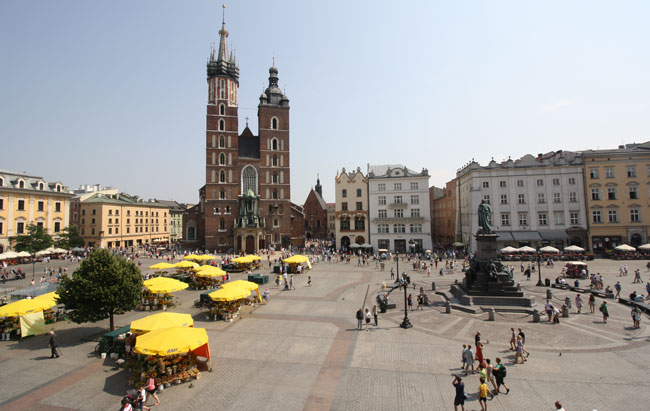
“The tower is almost 700 years old and is the only remaining part from the old Town Hall, demolished in the 1820s because the building was in very bad condition,” says tower attendant Krzysztof Przybyla.
“The view is beautiful, and with good weather you can see the Tatra Mountains about 100 kilometers from here – the highest mountains in Poland.”
Huffing and puffing the 239 steps up St. Mary’s taller Bugle-Call Tower, with narrow stone stairwells followed by steep wooden ones, may challenge the hardiest of visitors.
But the views are the best yet, looking down on the other side of Cloth Hall with the statue of Polish poet Adam Mickiewicz flanked by allegorical figures, and the tiny – at least from this vantage point – domed St. Adalbert’s church, one of Krakow’s oldest.
The Sad Story Behind The Two Towers
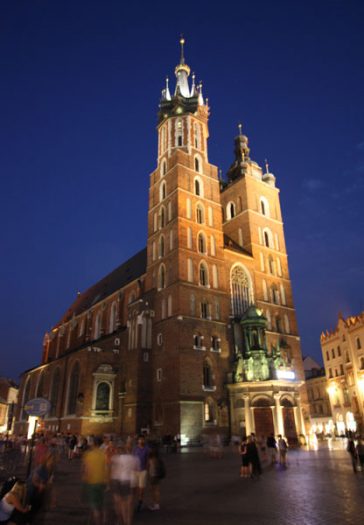
Stemming from tradition or perhaps legend, a bugler blows his horn every hour from the taller tower, stopping each time in mid-note.
“An arrow pierced the neck of the guard who was playing during battle and he couldn’t finish.
And now the bugler plays in the same way, suddenly stopping,” explains Weigel. “People cheer in the square – it’s a nice tradition.”
Yet another legend explains why one tower is taller than the other.
The older of two competing brothers built the taller North Tower and then murdered his younger brother before the South Bell Tower could be completed.
The elder brother then felt remorseful and jumped to his death.
Back on the ground, I enter St. Mary’s Church to see the 42-foot-high, multi-paneled 15th century alter paintings, a must see.
I stroll over to Cloth Hall with its cramped vendor stalls selling the likes of Polish ceramics and religious figurines, dishes, music boxes and more, reminding me of just one stretch of Istanbul’s colossal Grand Bazaar.
It’s here I find yet another view from above – just one flight up – on the balcony of trendy Café Szal.
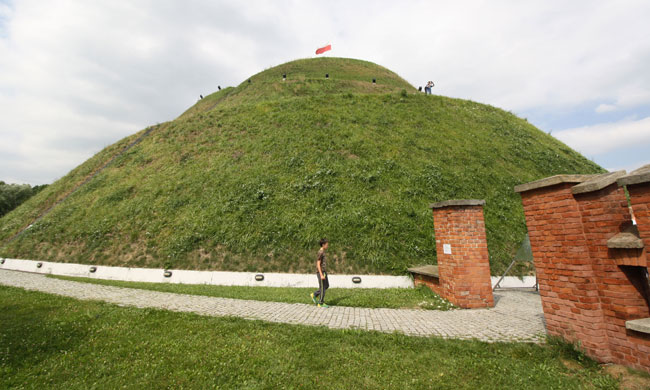
A short bus ride from the city center, the 112-foot-high Tadeusz Kościuszko Mound, a tribute to the Polish and American Revolutionary war hero, beholds wide-reaching views of the entire metropolitan area.
“Kościuszko built fortifications in Saratoga and West Point, and later came back to Krakow and organized an uprising against Russia,” says Weigel. “He lost, but we made him a hero.”
Other views from above include a look down Floriańska Street from atop the 13th century stone Florian Gate and old city walls, an area now showcasing local artists’ paintings.
Academy of Music students enjoy rooftop views including St. Mary’s Church from a sixth-floor restaurant terrace.
Subterranean spaces, meanwhile, allow visitors to explore Krakow from below.
The Market Square
Under Market Square, the Rynek Underground Museum showcases ruins of brick market stalls and cobbled roads that had been filled in over the centuries – all uncovered during recent excavations.
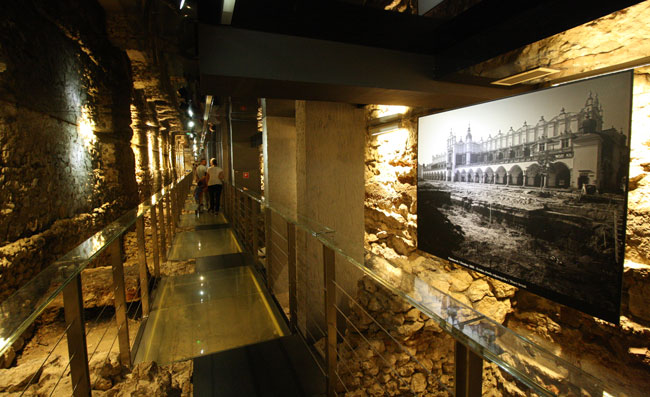
A gas-fueled, fire-breathing dragon sculpture fronts the so-called Dragon’s Den, a jagged-edged cave under Wawel Hill. According to legend, the man-eating serpent once lived there.
“A lot of brave knights tried to kill the dragon but it was too big and strong,” explains Weigel. “One day, a shoemaker fed it a lamb filled with sulfur.
When the dragon ate it, it kept drinking and drinking water from the Vistula River until it exploded.”
Outside the city, visitors descend more than 800 steps – nearly 450 feet – into the Wieliczka Salt Mine and pass salt sculptures along the way.
Lit by the dulled sparkle of salt chandeliers, the key attraction is the Chapel of St. Kinga with a carved salt alter and three-dimensional salt reliefs including a nativity scene and the Last Supper.
To the side stands a larger-than-life salt figure of Pope John Paul II, sculpted in 1999.
“The work of the miners was very dangerous, so they prayed a lot,” says Wieliczka guide Agnieszka Gancarz. “So this is a good place for praying and silence.”
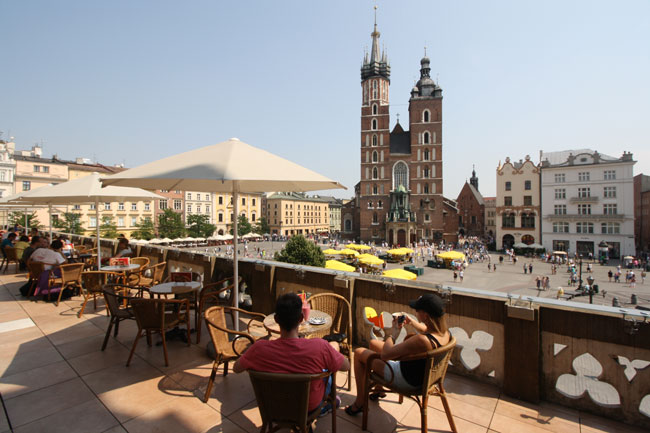
If You Travel to Krakow
Helpful information:
https://www.poland.travel
https://www.krakow-poland.com/
Author Bio: Houston-based writer and former TV news reporter RICHARD VARR is a member of the Society of American Travel Writers (SATW). He’s a longtime contributor to cruise, RV and AAA magazines as well as other publications and websites.
- How to Renew a US Passport Quickly and Affordably - April 19, 2024
- 6 Reasons to Visit Portland, Maine (+ Travel Tips) - April 18, 2024
- Cruising with Discovery Princess on the Mexican Riviera - March 30, 2024
